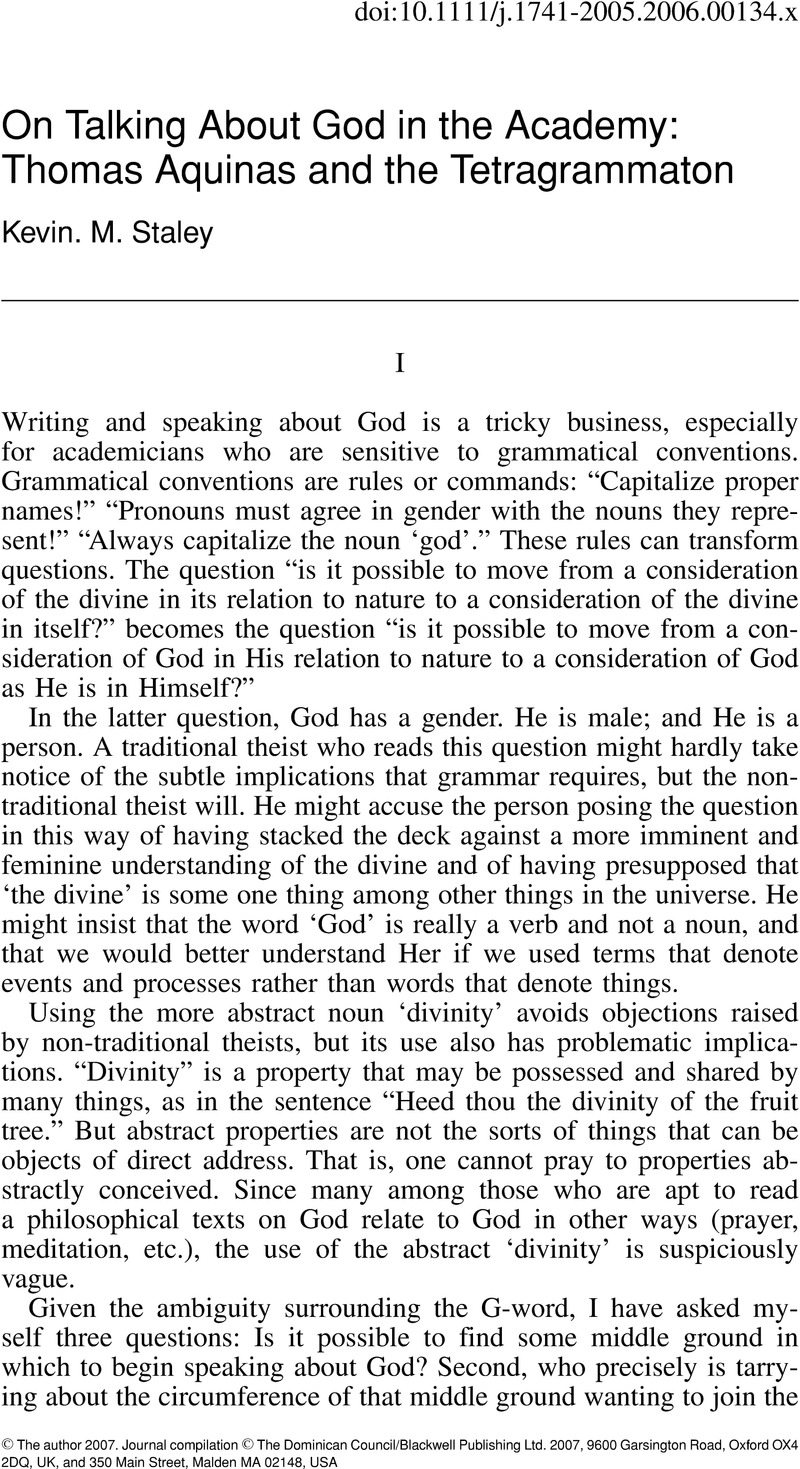No CrossRef data available.
Article contents
On Talking About God in the Academy: Thomas Aquinas and the Tetragrammaton
Published online by Cambridge University Press: 01 January 2024
Abstract

- Type
- Original Articles
- Information
- Copyright
- Copyright © The Author 2007. Journal compilation © The Dominican Council/Blackwell Publishing Ltd 2007, 9600 Garsington Road, Oxford OX4 2DQ, UK and 350 Main Street, Malden, MA 02148, USA
References
1 Summa Theologiae (hereafter ST) I, 13, 8, resp.
2 Wicker, Kathleen O'Brien tr., Porphyry the Philosopher – To Marcella: Text and Translation (Atlanta: Scholars Press, 1987), p. 57, ll. 209–210Google Scholar.
3 See ST I, 13, 9; see esp. ad 2: “nomen deus est nomen appelativium, et non proprium, quia significat naturam divinam ut in habente.”
4 As Henri Bergson has observed in his Introduction to Metaphysics: “I get a different point of view regarding the person with every added detail I am given. All the traits which describe it to me, yet can enable me to know it by comparison with other persons or things I already know, are signs by which it is symbolically expressed. Symbols and points of view then place me outside it; they give me only what it has in common with others. But what is properly itself cannot … . be expressed by symbols, being incommensurable with everything else.” Bergson, H, An Introduction to Metaphysics: The Creative Mind (Totowa, New Jersey: Rowman and Allanheld, 1983)Google Scholar, tr. Mabelle L. Andison; p. 160.
5 “dixit Deus ad Mosen ego sum qui sum ait sic dices filiis Israhel qui est [YHVH] misit me ad vos”
6 ST I, 13, 11, resp.
7 In the first half of Exodus, 3.14 God refers to Himself with the phrase “I am who am.”“Tetragrammaton” is a Greek term that describes the four-letter name (Yod He Vav He) that God gives Himself in the latter half of the same verse. See note 5 above. Thus, Aquinas makes a distinction between the Tetragrammaton and “qui est” even though “qui est” is the Latin translation of the Hebrew word to which Tetragrammaton refers. The Greek term occurs only four times in the writings of Aquinas. He mentions it twice during his treatment of the names of God in Summa Theologiae I, Q. 13. It occurs again in a quotation from pseudo-Jerome in Aquinas' commentary on the Gospel of Mark, 1.7. He uses the term only once while arguing against the Arians in Summa Contra Gentiles IV, 7. The source of Aquinas' familiarity with the term is uncertain. He most likely came across it while reading Jerome's correspondence with Marcella. It is the ninth name of God mentioned by Jerome in Epistle XXV. (See Patrilogia Latina XXII, p. 429: “Nonum tetragrammon … .id est ineffabile putaverunt, quod his litteris scribitur, jod, he, vav, he.” Aquinas never cites this letter, but he does cite Letter LIX, also to Marcella, in De Malo, Q. 14, Art. 6, obj. 1 (which indicates that Aquinas was familiar with Jerome's correspondences with Marcella.)
8 ST_I, 13, 11, ad 1.
9 “Tetragrammaton” does occur in M. Friedlander's translation of the Guide (New York: Dover Publications, 1956), p. 90. Its appearance there is apparently an addition by the translator. The term is absent in the more recent translation, Guide of the Perplexed, tr. Shlomo Pines (Chicago: University of Chicago Press, 1963). Future citations of the Guide are taken from the Pines translation.
10 Guide of the Perplexed, I, 63; p. 153.
11 Guide of the Perplexed I, 65, p. 155.
12 Guide of the Perplexed I, 61, p. 148.
13 Guide of the Perplexed I, 61, p. 148.
14 Guide of the Perplexed I, 61, p. 148.




